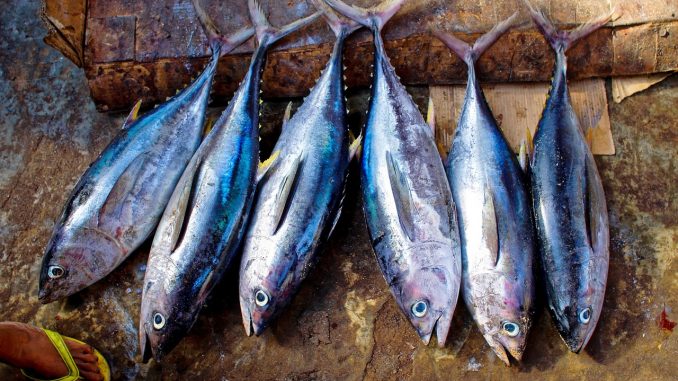
Tuna is possibly the most widely sought after fish in the world – even more so than salmon. It is certainly commercially one of the most important and there are many countries which rely on the economy associated with the fish.
If you look around the world, countries like the USA, a number of Mediterranean countries like Spain and many in the Far East including Thailand rely on sourcing this product. It is also one of the most highly processed animal foods too because canned tuna is probably available everywhere. The USA has made canned tuna its fish of choice and it sits beautifully in a niçoise salad. The top five tuna suppliers to the USA are currently by volume, Thailand, China, Indonesia, Vietnam and Ecuador.
For the Vietnamese, the Vietnam Association of Seafood Exporters and Producers (VASEP) reported that in July 2018, tuna export earning were estimated at 48.4 million US dollars. That is an awful lot of money to make from a fishing industry.
Tuna itself is a saltwater fish which is always found in warm seas. Sometimes it ventures into colder Atlantic waters for example but it is rarely seen. One fisherman recorded a monster breaking catch back in 2017 when he reeled in a 500lb tuna off the Pembrokeshire coast in Wales. This particular fish was an Atlantic Bluefin Tuna (Thunnus thynnus) which was 7ft 7 inches long and apart from a shark one of the biggest ever recorded. This particular species was once to be found in UK waters but overfishing by industrialised processing for mackerel and herring after World War II decimated the fish stocks. It is hoped this fish species will return to British waters. This particular tuna resides in the Atlantic and even Japanese fishing boats will venture onto the high seas to catch this particular fish. At the moment, the International Union of the Conservation of Nature regards them as endangered.
Bluefin tuna generally is extremely popular. It has a buttery flavour not found with other tuna. For many the Pacific Bluefin tuna is the most sought after but overfishing, yet again following the second world war meant its stock fell to 3% of unfidhed levels before teh 1950s. Another bluefin which is struggling to recover is the Southern Bluefin which is at 13% of its level before the war. Other commercial species include Yellow-fin Tuna (Thunnus albacares).
In Far Eastern cuisine, fish slices known as sashimi are as much a part of the food culture as is sushi. For the Japanese and Taiwanese, sashimi, nigiri and sushi have been raised to art forms. Indeed, in January 2018, a tuna sold for a record 323 thousand US dollars at the Tsukiji’s auction house – staggering ! At this remarkable Tokyo heritage landmark, aggressive bidding starts on the first tuna of the year. It is a tradition amongst market traders as a way of verifying to the world that it is a prosperous trade and the marketing exposure is enormous. For seven years, the ‘King of Tuna’, the restaurant owner Kiyoshi Kimura has been victor in the auction battlefield. From his point of view, an enormous amount of sushi is to be obtained.
One way to overcome the problems of overfishing in the sea would be to ‘ranch’ the fish. This is rather like salmon farming on a less managed scale. It is a practice that has been followed in the Med. since the mid-1990’s.
Even if you disapprove of tuna in a can or turn your nose up at its appearance in a salad, you can never be disappointed at the way this particular fish lasts so long in this type of packaging. Without canning, many of us globally would not have tasted this particular fish or benefited from its oily nutritional goodness. It’s also deboned too so none of that laborious waste of time having to fillet the fish and seeing much of the flesh minced by knife or fork. To be honest it tastes better than raw fish because it is often soaked in olive oil with lemon to keep its flavour.
The Americans are big fans of the fish but it was only into the 20th century that tuna entered their culture is a big way. The immigrants of southern Italy such as Sicily and Puglia, and those from Japan brought the taste of the fish with them. They sought it in the markets or even went fishing for it themselves.
There is a lot of skulduggery with tuna fishing. In August 2018, Spanish authorities recovered frozen tuna which was authorised for canning but was subsequently marked up as freshly caught tuna. To the perpetrators if thay had got away with this crime could have valued it at four times the canned value.
The SEPRONA is the Spanish Civil Guard. These guys seized 45 tons of the frozen tuna from four provinces Alicante, Cartagena, La Coruna and Barcelona. The fish had been treated with various additives to improve the colour so that they looked freshly caught rather than frozen or thawed. At the most a handful of people are being investigated and each could be imprisoned for between one and four years
References
, & (2017). Utilization of tuna processing byproducts: Protein hydrolysate from skipjack tuna (Katsuwonus pelamis) viscera. Journal of Food Processing and Preservation, 41, e13188.
NICE. Really interesting bit of news. I like your writing – quite short and pithy.
Really enjoyed reading your article. Full of great information. Thank you and keep up the good work.